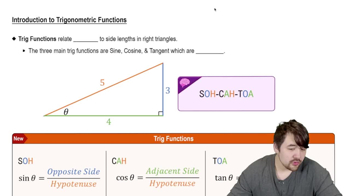Table of contents
- 0. Functions7h 52m
- Introduction to Functions16m
- Piecewise Functions10m
- Properties of Functions9m
- Common Functions1h 8m
- Transformations5m
- Combining Functions27m
- Exponent rules32m
- Exponential Functions28m
- Logarithmic Functions24m
- Properties of Logarithms34m
- Exponential & Logarithmic Equations35m
- Introduction to Trigonometric Functions38m
- Graphs of Trigonometric Functions44m
- Trigonometric Identities47m
- Inverse Trigonometric Functions48m
- 1. Limits and Continuity2h 2m
- 2. Intro to Derivatives1h 33m
- 3. Techniques of Differentiation3h 18m
- 4. Applications of Derivatives2h 38m
- 5. Graphical Applications of Derivatives6h 2m
- 6. Derivatives of Inverse, Exponential, & Logarithmic Functions2h 37m
- 7. Antiderivatives & Indefinite Integrals1h 26m
- 8. Definite Integrals4h 44m
- 9. Graphical Applications of Integrals2h 27m
- 10. Physics Applications of Integrals 2h 22m
4. Applications of Derivatives
Differentials
Problem 62
Textbook Question
Evaluate the following limits. Use l’Hôpital’s Rule when it is convenient and applicable.
lim_Θ→π/2 (tan Θ - secΘ)
 Verified step by step guidance
Verified step by step guidance1
First, identify the form of the limit as Θ approaches π/2. Substitute Θ = π/2 into the expression tan(Θ) - sec(Θ) to check if it results in an indeterminate form like 0/0 or ∞/∞.
Recognize that as Θ approaches π/2, tan(Θ) approaches ∞ and sec(Θ) also approaches ∞, leading to an indeterminate form of ∞ - ∞. To apply l'Hôpital's Rule, we need to rewrite the expression in a form suitable for the rule, typically as a fraction.
Rewrite the expression tan(Θ) - sec(Θ) as a single fraction. Recall that tan(Θ) = sin(Θ)/cos(Θ) and sec(Θ) = 1/cos(Θ). Combine these into a single fraction: (sin(Θ) - 1) / cos(Θ).
Now, check the new expression (sin(Θ) - 1) / cos(Θ) as Θ approaches π/2. Substitute Θ = π/2 to see if it results in an indeterminate form 0/0, which is suitable for l'Hôpital's Rule.
Apply l'Hôpital's Rule by differentiating the numerator and the denominator separately. Differentiate sin(Θ) - 1 to get cos(Θ), and differentiate cos(Θ) to get -sin(Θ). The new limit to evaluate is lim_Θ→π/2 (cos(Θ) / -sin(Θ)).
 Verified video answer for a similar problem:
Verified video answer for a similar problem:This video solution was recommended by our tutors as helpful for the problem above
Video duration:
7mPlay a video:
Was this helpful?
Key Concepts
Here are the essential concepts you must grasp in order to answer the question correctly.
Limits
Limits are fundamental in calculus, representing the value that a function approaches as the input approaches a certain point. They are essential for understanding continuity, derivatives, and integrals. In this context, evaluating the limit as Θ approaches π/2 involves analyzing the behavior of the functions tan(Θ) and sec(Θ) near that point.
Recommended video:

One-Sided Limits
l'Hôpital's Rule
l'Hôpital's Rule is a method for evaluating limits that result in indeterminate forms, such as 0/0 or ∞/∞. It states that if these forms occur, the limit of the ratio of two functions can be found by taking the derivative of the numerator and the derivative of the denominator. This rule simplifies the process of finding limits, especially when direct substitution leads to complications.
Recommended video:
Guided course

Power Rules
Trigonometric Functions
Trigonometric functions, such as tangent (tan) and secant (sec), are periodic functions that relate angles to ratios of sides in right triangles. Understanding their behavior, especially near critical points like π/2, is crucial for limit evaluation. In this case, tan(Θ) approaches infinity and sec(Θ) also approaches infinity as Θ approaches π/2, making the application of l'Hôpital's Rule relevant.
Recommended video:

Introduction to Trigonometric Functions







